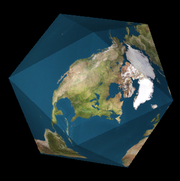Dymaxion map
|
|
Dymaxion_map_unfolded.png
The Dymaxion map of the Earth is a projection of a global map onto the surface of a three-dimensional regular solid, which can then be unfolded to a net in many different ways and flattened to form a two-dimensional map which retains most of the relative proportional integrity of the spherical globe map. It was created by Buckminster Fuller, and patented by him in 1946, the patent application showing a projection onto a cuboctahedron. The 1954 version published by Fuller under the title "The AirOcean World Map" used a slightly modified but mostly regular icosahedron as the base for the projection, and this is the version most commonly referred to today.
Fuller's Dymaxion map has many advantages over all of the other types of projections that render the 3D spherical globe as a 2D flat map. Among them are these:

- The proportions of all parts of the globe are rendered close to their true relative size. All the other common projections such as Mercator or Peters present the map from one point of view and relative size distortions increase towards the extremities. For instance, Mercator's projection, which is still in common use, stretches the poles out so that they are the same width on his map as the equator, which makes Canada appear to be many times larger than the United States land mass, and the polar icecap larger than both of them put together.
- The Dymaxion map has no 'right way up'. Fuller always argued that in this universe there is no 'up' or 'down', only 'in' and 'out'. Gravitational forces of the stars and planets created 'in', meaning 'towards the gravitational center', and 'out', meaning 'away fom the gravitational center'. Similarly 'north' and 'south' could not be interpreted as 'up' and 'down', or 'superior' and 'inferior', which is the orientation of all other map projections.
- The Dymaxion map does not perpetuate the cultural bias that is part of all other world map projections. The cultural and economic 'north/south' divide is reinforced by the north-up-superior/south-down-inferior presentation of all other world maps.
- There is no one 'correct' view of the global map. Peeling the triangular faces of the icosahedron apart in one way results in a icosahedral net that shows an almost contiguous land mass comprising all of earth's continents - not groups of continents divided by oceans. Peeling the solid apart in a different way presents a view of the world dominated by connected oceans surrounded by land.
For other maps that don't put north at the top, see Orientation of maps.
External links
- Fuller Map homepage (http://www.bfi.org/map.htm)
- PDF explanation of the map (http://www.bfi.org/pdf/bfi_mapFlyer_02.pdf)
- Dymaxion Project Animation (http://www.westnet.com/~crywalt/unfold.html)
- animation (http://friday.westnet.com/~crywalt/dymaxion_2003/dymaxion_2003.swf) - Flash format
